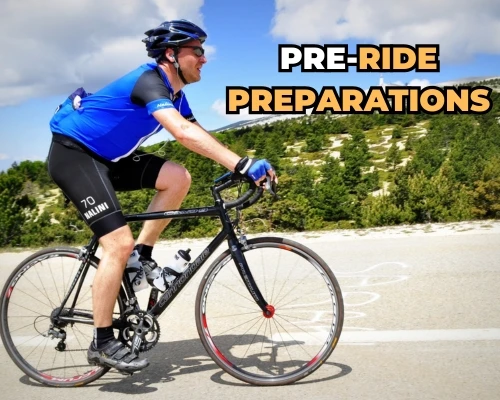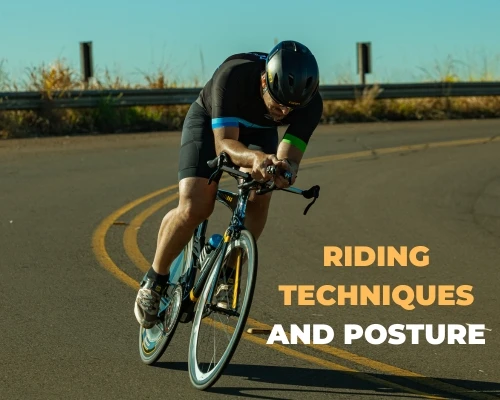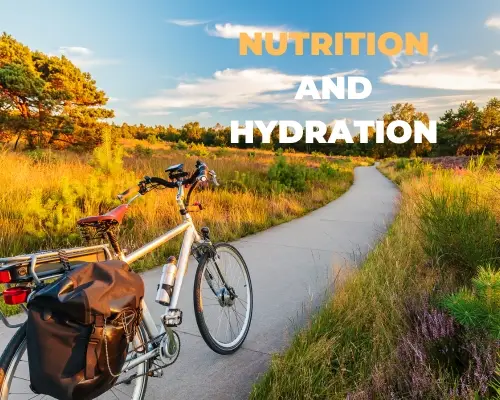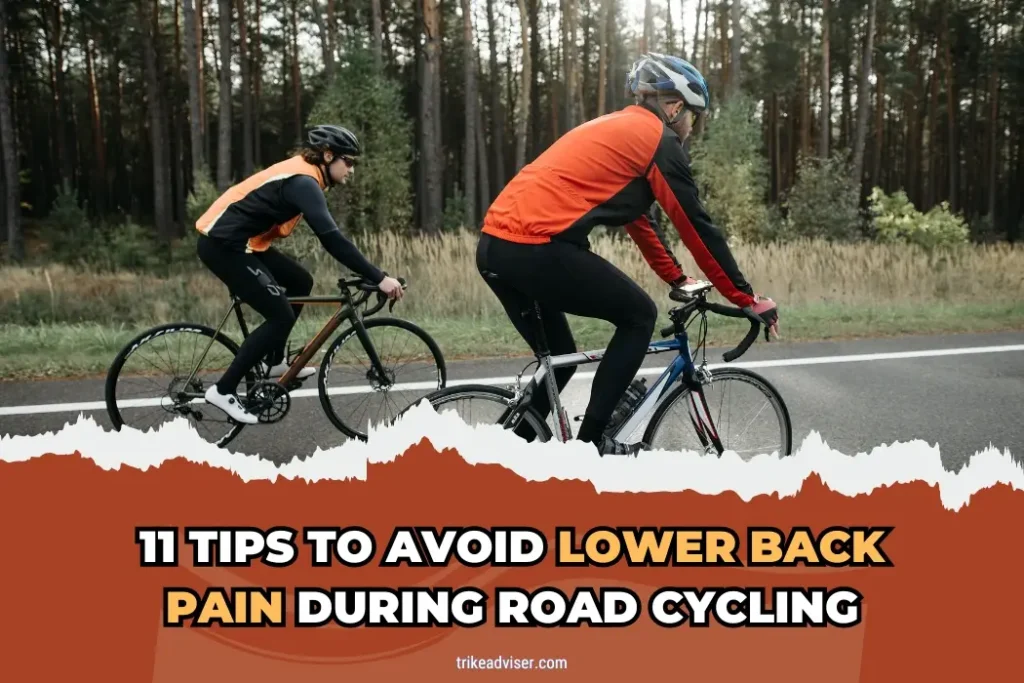Many cyclists accept lower back pain as part of the journey. Should they? Not necessarily. Riding shouldn’t mean tolerating discomfort. Yet, many of us grit our teeth, thinking it’s the norm. It’s not. Addressing this pain is simpler than you might think.
Do you often finish your rides with an aching back? Wonder if your posture or bike setup contributes to the discomfort? You’re not alone. The solution doesn’t lie in enduring more pain. It lies in understanding and applying specific strategies. These 11 tips offer a roadmap to pain-free cycling.
They address common mistakes and misunderstandings. Following them can transform your experience. Say goodbye to lower back pain. Welcome longer, more enjoyable rides. Interested? Keep reading.
11 Tips To Avoid Lower Back Pain During Road Cycling
Correct bike setup is fundamental. It reduces strain and enhances performance. Is your bike fit for you? It should match your measurements precisely. This fit minimizes back strain by aligning your posture. A professional fitting is worth its weight in gold. It adjusts seat height, handlebar reach, and more.
Strengthen Core Muscles
Your core is your cycling powerhouse. Strong core muscles support your back. They offer stability and reduce the risk of pain. Include core strengthening exercises in your routine. Planks, bridges, and leg lifts are excellent choices. A strong core equals a strong ride.
Check Handlebar and Seat Position
Handlebar and seat alignment is crucial. They should cater to your body’s proportions. Incorrect positions strain your back. The handlebar height and reach should allow a comfortable posture. Your seat should support your full pedal stroke without overextending. Consider professional help for perfect adjustments.
Reduce Weekly Mileage
Overuse is a common cause of back pain. Cycling too much, too soon, strains your back. Limit your weekly mileage. Gradually increase distance to build endurance safely. Listen to your body. It tells you when to push and when to rest.
Use Ice and Heat
After a long ride, care for your back. Apply ice to reduce inflammation. Follow up with heat to relax muscles. This combination soothes soreness effectively. It’s a simple yet effective way to manage discomfort.
Avoid Slouching
Posture matters. Slouching on the bike leads to muscle fatigue and pain. Keep your back straight and shoulders relaxed. This posture distributes your weight evenly. It reduces the burden on your lower back. Remember, good posture off the bike is just as important.
Leg to Chest Stretches
Stretching is your friend. Leg to chest stretches target the lower back. They relieve tension in the muscles. Perform these stretches before and after rides. They enhance flexibility and prevent stiffness. A flexible back is a happy back.
Adjust Pedal Stroke
Your pedal stroke influences your back’s health. Aim for a 90-degree angle at the top of the stroke. This position optimizes power and reduces strain. It ensures efficient cycling. Pay attention to your pedaling. Smooth, controlled strokes protect your back.
Take Breaks
Non-stop cycling strains your back. Break your rides into manageable segments. Take rest stops to stretch and relax. These breaks prevent muscle fatigue. They’re essential for long-distance rides. Your back will thank you for the respite.
Whole-Body Vibration
Be mindful of vibration. Uneven surfaces increase back pain risk. Vibration travels through the bike to your body. It aggravates your back over time. Choose routes carefully. Use bikes and accessories designed to absorb shock. Comfort is key to avoiding pain.
Seek Professional Help
Persistent back pain is a red flag. Don’t ignore it. Consult a healthcare professional. Doctors, chiropractors, and physical therapists offer valuable insights. They diagnose and treat underlying issues. Professional guidance ensures a pain-free cycling future.
Pre-Ride Preparations

Getting ready for a ride? Your pre-ride routine sets the stage. Let’s break it down.
Importance of a Proper Warm-Up Routine
Why Warm Up?
A solid warm-up primes your body. It ramps up blood flow and preps muscles for action. Think of it as revving your engine before hitting the road. Skipping it? You’re inviting trouble.
The Warm-Up Checklist
- Start Gentle: Begin with light cardio. A brisk walk or a slow pedal does wonders. Aim to get your heart rate up, gently.
- Dynamic Stretches: These aren’t your old-school stretches. They’re movements designed to wake up your cycling muscles.
Dynamic Stretches to Prevent Lower Back Pain
Stretch It Out
Dynamic stretches are your shield against lower back pain. They boost flexibility and slash strain risks. Key moves include leg-to-chest stretches and bridges. They’re your back’s best friends.
Core on the Floor
Don’t forget your core. Strong core muscles are like a sturdy backbone. They keep you stable and pain-free. Planks and bridges aren’t just for show. They build a fortress around your spine.
Perfect Posture
How you sit on your bike matters. Keep those arms relaxed but not straight. Aim for a 90-degree angle in your knee at pedal stroke’s top. It’s not just about looking good. It’s about riding pain-free.
Riding Techniques and Posture

Mastering your ride means mastering your posture. It’s about control, comfort, and safety. Let’s dive into the essentials.
The Art of Maintaining Correct Posture During Rides
Stay Aligned
Your posture on the bike is your foundation. Keep your head up and eyes forward. Your hands? They belong on the handlebars, gripping just right—not too tight. Feet should pedal from a stable, balanced position. This alignment isn’t just for show. It ensures you’re ready for anything the road throws your way.
Balance and Control
A correct posture means you can shift your weight smoothly. Need to take a sharp turn or dodge a pothole? Your posture has got you covered. It’s about staying balanced, so you stay on the bike, not beside it.
How to Adjust Your Riding Style for Long-Distance Comfort
Ergonomic Adjustments
Long rides shouldn’t be a pain. Adjusting your bike to fit you perfectly can change everything. Handlebar too far? Bring it closer. Saddle too low? Raise it up. These tweaks mean less strain on your back and more miles with smiles.
Stay Relaxed, Stay Engaged
Whether you’re on two wheels or four, relaxation is key. But stay engaged. Your body should be alert but not stiff. It’s a delicate dance of being ready without being tense.
Techniques to Distribute Your Weight Effectively
Stability Is Key
Weight distribution is crucial, no matter your ride. It’s about harmony between front and back. This balance keeps you stable over bumps and through turns. It’s the secret to smooth riding.
Master the Shift
Learning to shift your weight effectively is a game-changer. It’s not just moving; it’s moving with purpose. Anticipate the road ahead and adjust. This foresight prevents surprises and keeps your ride smooth and steady.
Nutrition and Hydration

The Right Fuel Matters
Protein powers muscles. It’s essential. Vitamins A, B6, C, E, zinc, iron, copper too. They keep you going. Calcium? It’s for strong bones, a sturdy spine. Anti-inflammatory foods reduce swelling, pain. Less stress, better nutrient absorption. Remember, it’s all connected.
Water is Key
Hydration prevents cramps, injuries. Dehydration brings muscle cramps, fatigue. Drink before, during, after rides. Electrolytes lost in sweat must be replaced. Sports drinks help. Monitor hydration by urine color. Pale straw? You’re good. Muscle cramps, fatigue signal dehydration.
Real-Life Stories and Case Studies
Hearing how others beat lower back pain? Priceless. Let’s dive into their stories and lessons from the pros.
Testimonials from Cyclists Who Overcame Lower Back Pain
Stories That Inspire
Cyclists like you and me, they’ve been there. Struggling, searching for relief. Then, breakthroughs. Adjusting bike fits, strengthening cores, changing postures. They share to inspire, to guide. Their message? Pain isn’t the end. It’s a challenge to overcome.
Practical Tips Shared
Their strategies vary. Yoga, Pilates, targeted exercises. Bike adjustments by pros. Every story, a lesson. A common thread? Persistence pays. Listening to your body is key. There’s hope, always.
Lessons Learned and Practical Advice from Cycling Coaches and Health Professionals
From the Experts
Coaches and health pros see it all. They’ve helped cyclists turn the corner, from pain to performance. Their wisdom? Invaluable.
Common Causes and Fixes
They pinpoint the culprits. Poor posture, inadequate bike fit, weak muscles. Their solutions? Tailored, effective. Strengthening routines, ergonomic adjustments, smarter training plans. Their advice stems from success stories and medical evidence. It’s gold.
Tailored Guidance
Every cyclist is unique. So is every back pain story. Coaches and health pros offer customized plans. They mix science with real-world testing. The result? Strategies that actually work. They make pain-free cycling not just a dream, but reality.
As an Amazon Associate, I earn from qualifying purchases, at no additional cost to you. Read Our Affiliate Disclosure.

